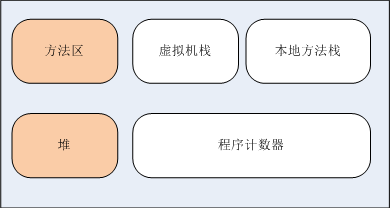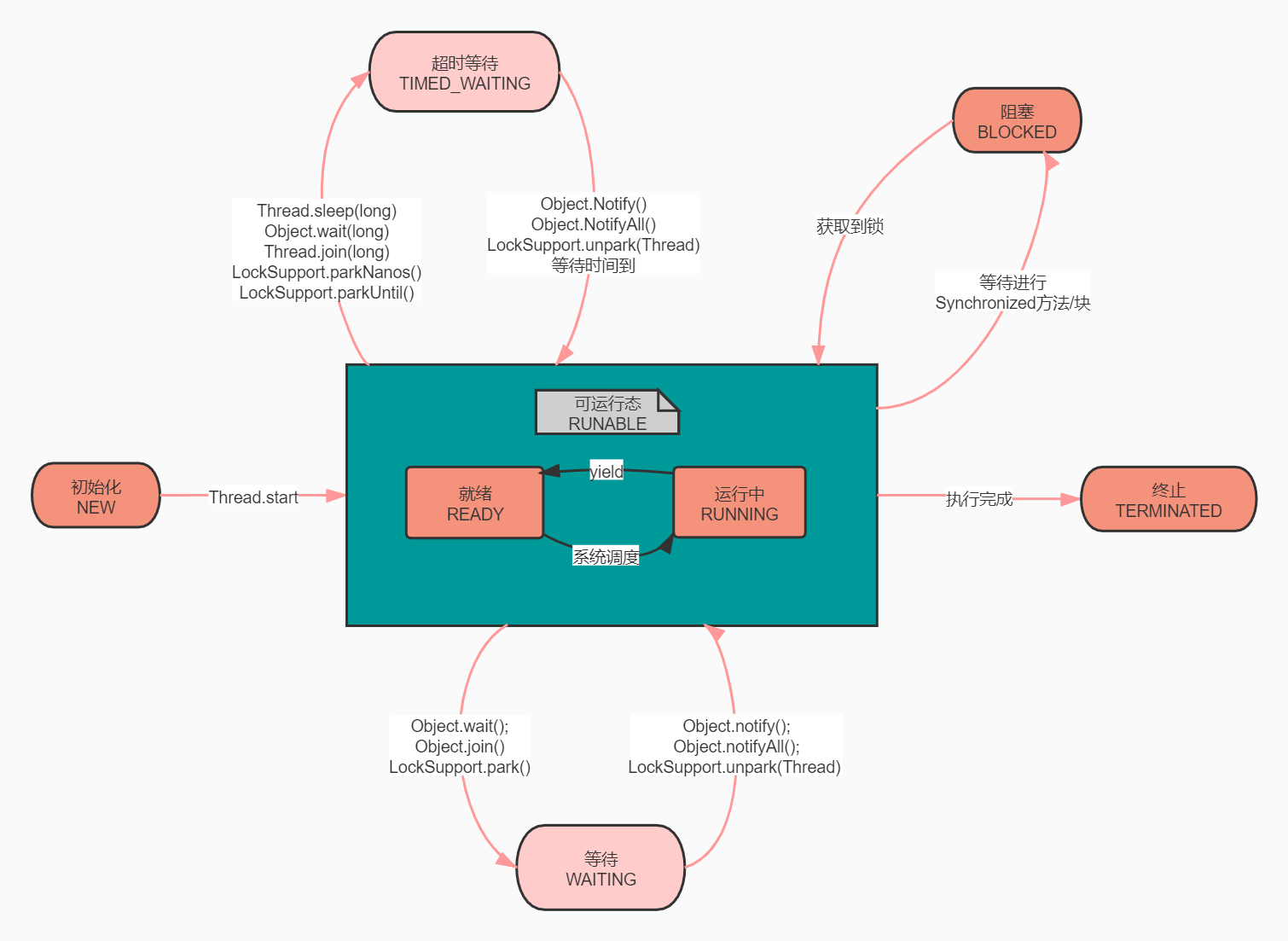关于Java多线程
进程 & 线程
计算机中的一个任务称为一个进程,进程内部的子任务称为线程
操作系统调度的最小任务单位是线程。Windows、Linux等操作系统都采用抢占式多任务,如何调度线程完全由操作系统决定,程序自己不能决定什么时候执行,以及执行多长时间
多任务既可以由多进程实现,也可以由单进程内的多线程实现,还可以混合多进程+多线程
多线程对比多进程,优点在于
- 创建线程开销小,尤其是在Windows系统上
- 线程间通信速度更快,因为可以共享变量
也有一些缺点,比如
- 稳定性较低,任何一个线程崩溃会直接导致整个进程崩溃
Java多线程模型
Java线程内存模型中,可以将虚拟机内存划分为两部分内存:主内存和线程工作内存,主内存是多个线程共享的内存,线程工作内存是每个线程独享的内存

在上图中,方法区和堆内存就是主内存区域,而虚拟机栈、本地方法栈以及程序计数器则属于每个线程独享的工作内存
Java内存模型规定所有成员变量都需要存储在主内存中,线程会在其工作内存中保存需要使用的成员变量的拷贝,线程对成员变量的操作(读取和赋值等)都是对其工作内存中的拷贝进行操作
各个线程之间不能互相访问工作内存,线程间变量的传递需要通过主内存来完成
Java线程生命周期
Thread.State枚举类中定义了六种线程状态,分别是NEW,RUNNALBE,BLOCKED,WAITING,TIMED_WAITING,TERMINATED,其生命周期流程如下

线程创建方法
方法一:从Thread派生一个自定义类,然后覆写run()方法
方法二:定义一个类,实现Runnable接口的run()方法;创建Thread实例时,将其传入
线程启动方法
调用Thread.start()方法,其内部是调用了private native void start0()方法,该start0()方法是由JVM虚拟机内部的C代码实现的,不是由Java代码实现的
线程设定优先级
调用Thread.setPriority(int n)设定优先级,可选范围1-10,默认是5。优先级高的线程被操作系统调度的优先级较高,但具体调度顺序依然由操作系统决定,我们不能通过设置优先级来保证某个线程一定会被先执行
线程等待
Thread.sleep(long millis)使当前线程等待millis毫秒,等待期间线程处于TIMED_WAITING状态
t.join()使当前线程等待目标线程t结束后继续运行;也可以传入一个long类型的参数,t.join(long millis)表示等待至多millis毫秒后继续运行,超过该时间若目标线程仍未结束,则不再等待;对已经运行结束的线程调用join()方法会立刻返回
线程中断
调用目标线程的interrupt()方法可以向其发送中断请求
- 如果目标线程处在等待状态,会抛出
InterruptedException,需对其捕获处理 - 如果目标线程处在运行状态,代码可以通过
isInterrupted()方法判断状态,作相应逻辑处理
或者改变自定义标志位的值,在代码中通过监测标志位的值来判断是否有中断
守护线程
Java程序入口是由JVM启动main线程,main线程又可以启动其他线程。当所有线程都运行结束时,JVM退出,进程结束。可以通过调用t.setDaemon(true)将目标线程设置为守护线程Daemon Thread,JVM退出时不会考虑守护线程是否结束,即守护线程可以在JVM退出后继续存在
t.setDaemon()方法一定要在t.start()之前调用,一旦启动后,无法再更改为守护线程
需要注意的是,守护线程不能持有任何需要关闭的资源,例如打开文件等,因为JVM退出时,守护线程没有任何机会来关闭文件,这会导致数据丢失
示例
1public class SimpleThread extends Thread {
2
3 @Override
4 public void run() {
5 System.out.println("Thread " + this.getName() + " is running ...");
6
7 int count = 0;
8 int interval = 1000;
9
10 while (!isInterrupted()) {
11 try {
12 Thread.sleep(interval);
13 System.out.println("Thread " + this.getName() + " waited for " + ++count + " seconds");
14 } catch (InterruptedException e) {
15 System.out.println("Thread " + this.getName() + " interrupted");
16 }
17 }
18
19 System.out.println("Thread " + this.getName() + " finished");
20 }
21}
22
23public class SimpleRunnable implements Runnable {
24
25 public volatile boolean running = true;
26
27 @Override
28 public void run() {
29 System.out.println("Thread " + this.toString() + " is running ...");
30
31 int count = 0;
32 int interval = 1000;
33
34 while (running) {
35 try {
36 Thread.sleep(interval);
37 System.out.println("Thread " + this.toString() + " waited for " + ++count + " seconds");
38 } catch (InterruptedException e) {
39 System.out.println("Thread " + this.toString() + " interrupted");
40 }
41 }
42
43 System.out.println("Thread " + this.toString() + " finished");
44 }
45}
46
47public class ThreadLab {
48
49 private void simpleStartThread() {
50 /**
51 * Option 1 : Define a thread class by extending the Thread class
52 */
53 Thread t1 = new SimpleThread();
54
55 /**
56 * Option 2 : Define a thread class by implementing Runnable interface and pass it to Thread class as construction parameter
57 */
58 SimpleRunnable simpleRunnable = new SimpleRunnable();
59 Thread t2 = new Thread(simpleRunnable);
60
61 /**
62 * Start threads
63 */
64 t1.start();
65 t2.start();
66
67 try {
68 Thread.sleep(1000);
69
70 /**
71 * Interrupt thread 1 by invoking interrupt()
72 */
73 t1.interrupt();
74 t1.join();
75
76 /**
77 * Interrupt thread 2 by setting running flag to false
78 */
79 simpleRunnable.running = false;
80 t2.join();
81 } catch (InterruptedException e) {
82 System.out.println("Sub thread interrupted");
83 }
84
85 /**
86 * this is a daemon thread, which will not be terminated when JVM quit
87 */
88 Thread t3 = new SimpleThread();
89 t3.setDaemon(true);
90 t3.start();
91
92 System.out.println("Main thread finished");
93 }
94
95 public static void main(String[] args) {
96 ThreadLab threadLab = new ThreadLab();
97 threadLab.simpleStartThread();
98 }
99}